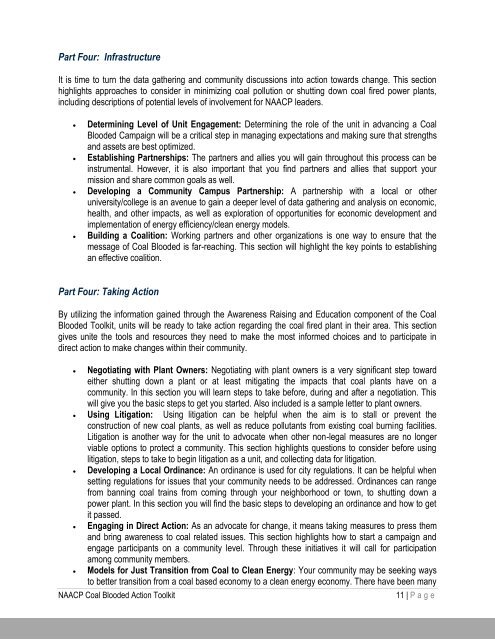Coal Blooded Action Toolkit - Climate Access
Coal Blooded Action Toolkit - Climate Access
Coal Blooded Action Toolkit - Climate Access
- No tags were found...
Create successful ePaper yourself
Turn your PDF publications into a flip-book with our unique Google optimized e-Paper software.
Part Four: InfrastructureIt is time to turn the data gathering and community discussions into action towards change. This sectionhighlights approaches to consider in minimizing coal pollution or shutting down coal fired power plants,including descriptions of potential levels of involvement for NAACP leaders.Determining Level of Unit Engagement: Determining the role of the unit in advancing a <strong>Coal</strong><strong>Blooded</strong> Campaign will be a critical step in managing expectations and making sure that strengthsand assets are best optimized.Establishing Partnerships: The partners and allies you will gain throughout this process can beinstrumental. However, it is also important that you find partners and allies that support yourmission and share common goals as well.Developing a Community Campus Partnership: A partnership with a local or otheruniversity/college is an avenue to gain a deeper level of data gathering and analysis on economic,health, and other impacts, as well as exploration of opportunities for economic development andimplementation of energy efficiency/clean energy models.Building a <strong>Coal</strong>ition: Working partners and other organizations is one way to ensure that themessage of <strong>Coal</strong> <strong>Blooded</strong> is far-reaching. This section will highlight the key points to establishingan effective coalition.Part Four: Taking <strong>Action</strong>By utilizing the information gained through the Awareness Raising and Education component of the <strong>Coal</strong><strong>Blooded</strong> <strong>Toolkit</strong>, units will be ready to take action regarding the coal fired plant in their area. This sectiongives unite the tools and resources they need to make the most informed choices and to participate indirect action to make changes within their community. Negotiating with Plant Owners: Negotiating with plant owners is a very significant step towardeither shutting down a plant or at least mitigating the impacts that coal plants have on acommunity. In this section you will learn steps to take before, during and after a negotiation. Thiswill give you the basic steps to get you started. Also included is a sample letter to plant owners. Using Litigation: Using litigation can be helpful when the aim is to stall or prevent theconstruction of new coal plants, as well as reduce pollutants from existing coal burning facilities.Litigation is another way for the unit to advocate when other non-legal measures are no longerviable options to protect a community. This section highlights questions to consider before usinglitigation, steps to take to begin litigation as a unit, and collecting data for litigation. Developing a Local Ordinance: An ordinance is used for city regulations. It can be helpful whensetting regulations for issues that your community needs to be addressed. Ordinances can rangefrom banning coal trains from coming through your neighborhood or town, to shutting down apower plant. In this section you will find the basic steps to developing an ordinance and how to getit passed. Engaging in Direct <strong>Action</strong>: As an advocate for change, it means taking measures to press themand bring awareness to coal related issues. This section highlights how to start a campaign andengage participants on a community level. Through these initiatives it will call for participationamong community members. Models for Just Transition from <strong>Coal</strong> to Clean Energy: Your community may be seeking waysto better transition from a coal based economy to a clean energy economy. There have been manyNAACP <strong>Coal</strong> <strong>Blooded</strong> <strong>Action</strong> <strong>Toolkit</strong>11 | P a g e











